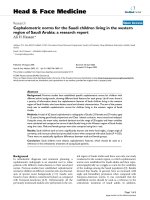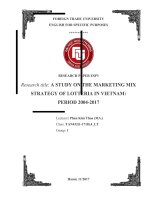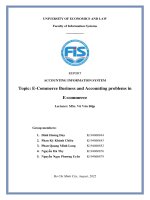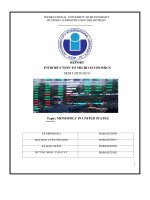tiểu luận report topic business in the western world
Bạn đang xem bản rút gọn của tài liệu. Xem và tải ngay bản đầy đủ của tài liệu tại đây (2.43 MB, 23 trang )
<span class="text_page_counter">Trang 1</span><div class="page_container" data-page="1">
<b>CROSS-CULTURAL MANAGEMENT</b>
<b>REPORT </b>
<b>BUSINESS IN THE WESTERN WORLD</b>
Professor : Tran Thi Minh DuyenClass : 47K01.4
Members : Pham Thi Thuy DuongHo Hoang NhiNguyen Thi Ngoc OanhNguyen Thi Phuong Thao
<i>Da Nang, November 25 , 2023<small>th</small></i>
</div><span class="text_page_counter">Trang 2</span><div class="page_container" data-page="2"><b>TABLE OF CONTENTS</b>
<b>TABLE OF CONTENTS...I</b>
<b>I.LATIN EUROPE...2</b>
1. Societal cultural practice and values...2
2. Leadership profile scores...4
3. Concluding Tips for Doing Business in Latin Europe...4
<b>II.GERMANIC EUROPE...6</b>
1. Societal cultural practice and values...6
2. Leadership profile scores...9
3. Concluding Tips for Doing Business in Germanic Europe...9
<b>III.NORDIC EUROPE...10</b>
1. Societal cultural practice and values...11
2. Leadership profile scores...12
<b>IV.EASTERN EUROPE...13</b>
1. Societal cultural practice and values...14
2. Leadership profile scores...15
<b>CONCLUSION... 17</b>
</div><span class="text_page_counter">Trang 3</span><div class="page_container" data-page="3"><b>TABLE OF FIGURES</b>
Figure 1. Cultural Practices and Values in the Latin Europe Group...2Figure 2. Leadership Scores for Outstanding Leadership in the Latin Europe Group...4Figure 3. Cultural Practices and Values in the Germanic Europe Group...6Figure 4. Leadership Scores for Outstanding Leadership in the Germanic EuropeGroup... 9Figure 5. Cultural Practices and Values in the Nordic Europe Group...11Figure 6. Leadership Scores for Outstanding Leadership in the Nordic Europe Group... 12Figure 7. Cultural Practices and Values in the Eastern Europe Group...14Figure 8. Leadership Scores for Outstanding Leadership in the Eastern Europe Group... 15
</div><span class="text_page_counter">Trang 4</span><div class="page_container" data-page="4"><i>Cross-Cultural Management – Group 2 – 47K01.4 </i>
The Western world refers to European countries, North America, SouthAmerica, Australia and New Zealand. The dominant race is white, which also includesLatin America, Türkiye, Eastern Europe, South Africa, Russia and Israel. The Westernworld is famous for its cultural, linguistic, historical diversity and it plays animportant role in the world economy and politics. It is also a diverse and complexcontinent with cultural, historical and economic prominence. This makes it one of themost important regions in the world, with great influence on both world economicsand politics. With its linguistic, cultural and historical diversity, it is a region full ofopportunities and challenges in the business sector, GLOBE (Global Leadership andOrganizational Behavior Effectiveness) has classified the Western world into manyclusters based on business culture, to help better understand this diversity and how itaffects business activities.
In this report, we will focus on studying the business culture and tips forbusiness of the main clusters, including Germanic Europe and Latin Europe, as well asgive a brief overview of Eastern Europe, Nordic Europe and other countries belongingto Europe. We will explore the unique characteristics of each cluster and theimportance of our in-depth understanding of the culture of these clusters will help usbe more successful in cross-border business.
<b>Too long to read onyour phone? Save to</b>
read later on yourcomputer
Save to a Studylist
</div><span class="text_page_counter">Trang 5</span><div class="page_container" data-page="5"><b>I.LATIN EUROPE</b>
The Latin Europe cluster consists of France, Italy, Spain, Portugal, Switzerland(French-speaking), and Israel.
<b>1.Societal cultural practice and values</b>
The scores of this cluster are average on most cultural practices dimensions withthe exception of high scores on Power Distance and relatively low scores on HumaneOrientation.
About Power Distance, members of these societies do not expect power to bedistributed evenly among its citizens nor would they reward individuals for being kindand generous to others. The boss is the boss, and the authority of that person rests onthe need of a country’s people for strong rule. There is often a tension between thisdependence on and loyalty towards authoritarian figures and distrust of authoritariansystems in general. However, this cluster has very low scoring Power Distance values,which indicates that they prefer to have drastic reductions in power differences,
<i>Figure 1. Cultural Practices and Values in the Latin Europe Group</i>
</div><span class="text_page_counter">Trang 6</span><div class="page_container" data-page="6">The ratings of Gender Egalitarianism obtained the lowest score for this clusterbut it is about average for other clusters - all clusters are at least somewhat male-dominated. In Italy, although women in commerce and the professions are moreprevalent and accepted, their salaries and perks usually are not yet comparable to theirmale colleagues, even when the women have a superior education. However, they aremaking rapid progress, especially when such career women develop their ownpersonalized management style.
Future Orientation and In-Group and Institutional Collectivism are lower thanthe average of other clusters. This cluster scored higher on In-Group Collectivism thanInstitutional Collectivism, indicating significant family and group orientation but notparticularly encouraging a collective distribution of resources. For example, as a greatnumber of businesses in Italy are family-owned, many businesses lack managementprofessionals. The head of the family wants to maintain control over the business.Because they finance through debt, and because they want to maintain control at allcosts, they limit their growth, and subsequently cannot compete in the global market.On the other hand, these societies desire a modest increase in In-Group andInstitutional Collectivism, suggesting that they want more loyalty and cohesiveness intheir organizations and families, and desire more practices that reward and givesupport to the collective distribution of resources and collective action.
The Latin Europe cluster ranks high on Performance Orientation, In-GroupCollectivism, Future Orientation, and Humane Orientation values. Thus, they desire tohave significant increases in performance and future orientation, to be more humane.Interestingly, there seems to be a relatively small difference between cultural practiceand societal values scores on Uncertainty Avoidance and Assertiveness dimensionswhich indicates that the societies in this cluster find the current structure, rules, norms,and the level of assertiveness about relationships acceptable.
In short, the societies in this cluster are somewhat male-dominated, notparticularly humane-oriented, and experience an unequal distribution of power and
</div><span class="text_page_counter">Trang 7</span><div class="page_container" data-page="7"><b>2.Leadership profile scores</b>
<i>Figure 2. Leadership Scores for Outstanding Leadership in the Latin Europe Group</i>
The leadership dimensions viewed as most contributing to outstandingleadership in this cluster include Charismatic/Value- Based, followed by TeamOriented and Participative Leadership. These societies also value Team orientedleaders whose characteristics include developing outstanding teams by using theiradministrative and interpersonal skills to create cohesive working groups. Whileparticipative leadership is valued, its score is about average among the clusters.Among the other leadership dimensions, Humane- Oriented Leadership is viewed asslightly positive but is tied for lowest of all clusters. Autonomous Leadership isviewed as slightly negative and is more negative than most other clusters. Self-Protective Leadership is also viewed negatively indicating that these societies rejectleaders who are self-centered and status-conscious.
Overall, an outstanding leader in the Latin European cluster would be a personwho is moderately charismatic, team-oriented, and participative but not particularlycaring and giving or acting in an independent manner.
<b>3.Concluding Tips for Doing Business in Latin Europe</b>
For the initial contact, a third-party introduction is very helpful. If you can’t get
</div><span class="text_page_counter">Trang 8</span><div class="page_container" data-page="8">Third parties are often used to communicate important messages, especiallyunpleasant ones. A foreign businessperson must be aware of the hidden culturalassumptions. The best solution for this is to have a bilingual, bicultural person toadvise you.
Meeting: Try to build a relationship.
This is a relationship-oriented country, and if you form a relationship, you have abetter chance. You do that by taking time, finding out about the other person, andbuilding trust. It is perfectly acceptable to ask questions about family and expectto answer questions about yours.
Dress code: Look your best.
Specifically, Italian culture - "Bella figura" is the desire to make a goodimpression, to give a good appearance, and to convey a certain image as well asbehavior. The foreign businessperson is advised to imitate the Italians on this one. Forms of address: Be formal until the other person indicates that you may speak in
the familiar
In Latin Europe, they are initially quite formal, both in personal and businessrelationships. They adore the spectacle of form and ritual, even in businesssituations. The businessperson must be sure to know in advance the appropriatetitles. The above tendencies are evident in business cards, which may be of threekinds: formal with all the necessary business information, including titles anddegrees; informal without extensive titles, but which indicates that one has formeda less formal professional relationship; social or visiting card with just theperson’s name.
Make connections: Business discussions often take place over meals. Be preparedfor long, leisurely lunches or dinners where business matters might be discussedinformally. Don’t rush through these meals; they are an integral part ofrelationship-building.
</div><span class="text_page_counter">Trang 9</span><div class="page_container" data-page="9"><b>II. GERMANIC EUROPE </b>
The Germanic Europe cluster comprises Germany (former East and formerWest), Austria, The Netherlands, and Switzerland.
<b>1.Societal cultural practice and values</b>
The societal cultural practices for this cluster are noteworthy for especially highscores compared to other clusters on Performance Orientation, Assertiveness, FutureOrientation, and Uncertainty Avoidance.
The first thing is about Power Distance. Power Distance is relatively high, inGermany, the hierarchical positions are not as easily separated from the personsoccupying them. A respectful formality tends to prevail between company employeesoperating on different levels and in different areas of responsibility. The Germans aretitle conscious, and proper etiquette requires addressing them by their title. Also, thosewho have attained their PhD are addressed by the term doktor (i.e., “Herr DoktorSchmidt” or “Frau Doktor Braun”). However, when compared with other clusters, itdoes not particularly stand out among the others. Along with the Nordic countries,Germanic countries show lower power distance than their other fellow Europeans.
<i>Figure 3. Cultural Practices and Values in the Germanic Europe Group</i>
</div><span class="text_page_counter">Trang 10</span><div class="page_container" data-page="10">And they also desire much less Power Distance. This is reflected in a generalpreference for company employees to work in groups rather than making solo efforts.
High Assertiveness indicates more assertive and perhaps confrontationalrelationships with others. In business, they focus on working on the task at handdirectly instead of forming a personal relationship first. For this reason, it is also notuncommon for Germans to skip small talk and get directly to business, especially inwritten communication. The very high scores on Uncertainty Avoidance indicate thatthis society strongly endorses rules and procedures to reduce the uncertainty of futureevents. For example, Germans are very organized. Their attitude is to organize thetime allotted to its greatest efficiency, rather than wait and see what happens. Theyhave a reputation for quality and exactness—their buses, trains, and planes usually runon time. Detail in planning and project implementation is valued. German companiesrely heavily on experts and their knowledge to minimise insecurity. In cultural value,they also want to reduce Assertiveness, and Uncertainty Avoidance achieving thelowest scores among the clusters.
This Cluster has high scores on Performance Orientation and Future Orientationin culture practice. This profile indicates countries in this cluster reward performanceand value competitiveness. They are always focused on their work and try to achievemaximum work efficiency. In cultural value, the countries in the cluster desire to bemuch more Performance Oriented. The high Future Orientation indicates planning andinvesting for the future. They tend to adopt a longer-term perspective when makingstrategic decisions. The (potential) employer and employee are not just concernedwith the present requirements of a company, but also with the longer-termoccupational career of a candidate.
In contrast, this cluster has relatively low scores on Humane Orientation andboth In-Group and Institutional forms of Collectivism. Low scores on HumaneOrientation indicate a limited caring, altruism, and kindness to others. In culturalvalues, they want to be much more Humane. The low scores on the cultural dimension
</div><span class="text_page_counter">Trang 11</span><div class="page_container" data-page="11">within organizations and families and limited collective distribution of resources. Forexample, they are prone to centre mostly on their immediate relatives, which stands incontrast to collectivist cultures. Self-motivation and personal identity are importantvalues to Germans. Nor are the Germans normally an outward people; they tend to bevery private. They maintain a slightly larger personal space around themselves,usually standing six inches further back than do North Americans. However, inGermany, the principle of collective good is important in the idea of codetermination(mitbestimmung). Codetermination allows for worker input into the management ofthe firm. Any firm with more than five employees should have a worker’s council(Betriebsrat) that represents the employees and helps them solve various grievanceswith the firm’s management. Any coal or steel firm of more than 2,000 workers isrequired to have 50 percent of the company’s supervisory board composed of workers.Gender Egalitarianism is also relatively low indicating male dominance andgender inequality. Women's salaries are often lower than those of men in the same jobposition, and they often have difficulty moving forward in their careers. The countriesin the cluster desire to be much higher in Gender Egalitarian. For the latter dimensionof Gender Egalitarianism, they tie for the highest value score indicating a strong desireto be more gender equal. The German government has taken many measures to reducegender inequality, including promoting gender equality policies at work.
In conclusion, the countries in this cluster have high scores on PerformanceOrientation, Assertiveness, Future Orientation, and Uncertainty Avoidance, low scoreson Gender Egalitarianism, Humane Orientation and both In-Group and Institutionalforms of Collectivism. However, they also would like to change some indexes overtime.
</div>








